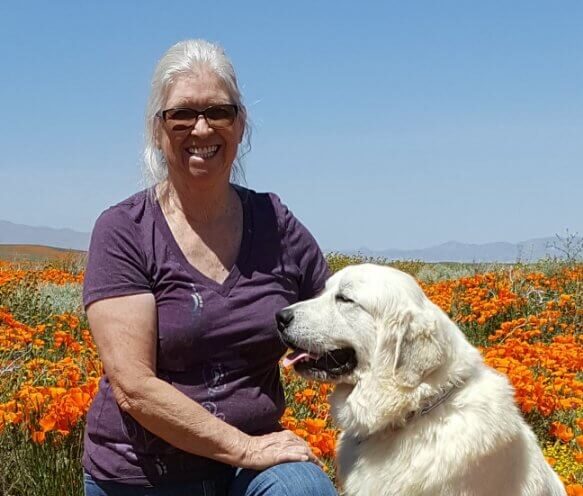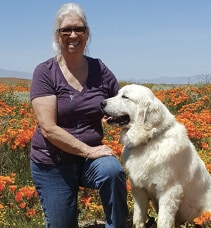Interview with Working Group Breeder Terry Denney-Combs
Where do I live? How many years in dogs? How many years as a breeder?
Terry Denney-Combs: I live in Hesperia, which is located in the High Desert area in the Southeastern part of California. I’ve been a breeder for 53 years. I started at 18 with Basset Hounds and, on my 21st birthday, started with Great Pyrenees. It’s been love ever since. I’ve achieved becoming an AKC Platinum Breeder of Merit.
What is my kennel name? How many dogs do I currently keep?
Terry Denney-Combs: My kennel name is Euzkalzale Great Pyrenees, and I usually keep four dogs here with me. I’m alone and want to spend time with my dogs. I have many Pyrs in homes with families that also show them and sometimes breed them.
Which show dogs from the past have been my noteworthy winners?
Terry Denney-Combs: CH Euzkalzale Sundance Legend is still #1 Breed for All-Time Stats. He showed from 1993 to 2000 and won his last Best in Show at Orange Empire Dog Club under Michelle Billings at the age of 10 years. He was in the Hall of Fame for both Showing and Producing Sire for the Great Pyrenees Club of America. We’ve managed to keep a few dogs in the rankings each year (usually Top 10) and in the Hall of Fame for show standings, and we have produced many fine bitches that have reached Hall of Fame for Producing Dam.
Which have been my most influential sires and dams?
Terry Denney-Combs: There are many sires and dams that have contributed. I choose to breed a bitch usually once or twice and then move on to the next generation. I spay the dam and place her in a home so that she has a chance at a very good life. Then I proceed to continue with the new offspring. This helps limit the number of pups I choose to breed. Good homes are always at a premium. I prefer to place the males because I can use them, and they will have lots of attention in their lives. Many are shown and continue on to be added to the breeding program when needed.
Can I talk a bit about my facilities? Where are my puppies whelped? How are they raised?
Terry Denney-Combs: My dogs have very large yards to play and socialize in, and they are house dogs besides. They live with me, and the pups are whelped in my bedroom where it is easy for me to keep an ear and eye on them; it’s more private from the other dogs, so the dam is content. I also keep a pen in the living room so that they can start getting used to TV noises, etc., as they grow older. At around six weeks, the litter and dam move to my puppy yard and start to join some of the other dogs occasionally to socialize. They also continue to come in the house at that age, and eventually get groomed, etc., as they grow. I want them used to a home environment. I do not sell to kennel facilities because I believe Great Pyrenees need a purpose in their lives—something to guard. They are flock guardians and need companionship.
What is my “process” for selecting show puppies? At what age do I make my decisions?
Terry Denney-Combs: I temperament test for livestock guarding ability at 5, 6 & 7 weeks. I do one-on-one challenges to see how sound in body and mind each pup is. Generally, a few will stand out. At eight weeks, I will evaluate by comparing them to the standard, and I’ll consider how well they tolerate grooming, staying in crates, and traveling. I prefer to wait until nine weeks for my last considerations because they are a very large dog and my lines are slow maturing. I generally will keep two and make my final choice at around eight months or so. Sometimes I keep both, and sometimes I place one. During this time, I get to know the pups and see which overall pup I want to add to the program.
How do I prepare my pups for the show ring? Does my breed require any special preparation?
Terry Denney-Combs: Great Pyrenees are shown in a natural coat, but it still takes roughly three hours to get a mature show dog ready. Most of the time is spent washing and drying the coat. The allowable trimming is just to tidy the feet and whiskers, and getting out some of the undercoat that causes the rump hair to stand up taller than the backline. Pups are groomed regularly, to accept all the time that is needed, generally always standing, especially on a table. (I think this goes back to their ancient ancestors standing on a hill, looking out over the sheep.) Transitioning of coat from puppy to adult happens at around 8 to 18 months, and we will often thin out the excess wisps of soft hair on the ears around this time. This doesn’t usually grow back, as the adult hair tends to lay flat. Being a double-coated breed, we are often dealing with the shed-out on a regular basis as well.
Is mine a cropped and/or docked breed? Can I share my thoughts on cropping and docking?
Terry Denney-Combs: Pyrs are neither a cropped nor a docked breed. They even have double dewclaws on their back legs and singles on front, so there’s no real removal of anything on Great Pyrenees.
I understand that docking and cropping had a purpose for the breeds that do it. I feel natural is better; one of the reasons why I have a natural breed.
If the fighting dogs are used for that purpose, I can understand the cropping to prevent tearing. Pyrs fight too, but they pull their ears back into their ruff and allow the looser skin in that area and the thick mane to protect the dog. I do think that too much importance is placed on the look of the cropping to the point that a worthy dog may be overlooked because one ear fails to stand or the crop just wasn’t what it should be. It’s not a part of that dog in its natural form, so points should not be deducted.
Docked breeds, I’m not sure about. Tails do help to contribute balance. I don’t feel I really know enough to have a noteworthy opinion.
Are Performance and Companion titles important to me as a breeder? Are parent club titles?
Terry Denney-Combs: Performance and Companion dog titles show me that the owner is spending time with the dog—best thing ever! Everyone likes their work appreciated. And by the parent club setting goals, it enables us to see how a breeder is fairing and what is important to them; all good things to have goals to strive for in your sport.
In my opinion, is my breed in good condition overall. Any trends that warrant concern?
Terry Denney-Combs: We are fortunate that Great Pyrenees is a very healthy breed overall. There are many new breeders coming into the breed, and many of them are doing all the testing they can to help the breed continue even healthier into the future. There is so much more we can learn about our breeding stock now. It’s exciting.
Is my breed well-suited to be a family dog? Who are the best candidates to own my breed?
Terry Denney-Combs: Pyrs are not the easiest dogs to live with and are quite independent in their own right. In certain situations, their barking to claim their property can be a nuisance to neighbors, even in rural settings, and they can wander if not contained adequately; they need to be on leash. Owners must understand this to have the enjoyment of these dogs for what they are, which does not include coming when called, fetching, etc. The people who have them and love them will have nothing else. Those who want a dog to be at their beck and call should seek another dog. They co-exist easily with people and blend into the pack unless their attention is needed for protection—and then we see another side. It is important that the person is the leader of the pack, but not necessarily in a dominant way; just to take the dog in-hand if he is making the wrong choice.
Do I feel that my breed is supported by a sufficient number of preservation breeders?
Terry Denney-Combs: Because our breed has many old-timers throughout the country, like myself, I feel it is in good hands. Many new faces with good ideas are coming into breed as well. With new breeders, they are either in for the long haul or they may be a “flash in the pan.” Time will tell. I pray that we continue to have the ones who stand the test of time.
For a bit of fun, what’s the most amusing thing I’ve ever experienced with a Working Dog?
Terry Denney-Combs: The funniest thing that I have seen one of my rather large (135 lb.) bitches do was an intentional yoga-type headstand. “K.D.” placed her head on the seat of a large chair and proceeded to do the headstand, with her back supported by the back of the chair as her rear legs waved in the air. She also thought she could lay on the back of the couch with the cat, and I occasionally found her standing on the dining room table when I came home.
Another one of our girls was in a home when the owner found her on top of an upright piano. This Pyr once tried to bring a very large tree branch into her home through the doggy door—finally figuring out how to turn so that it came in with her. “Voila,” messy den. I find Great Pyrenees endearing to no end, of course. They are my heart and my breed.









